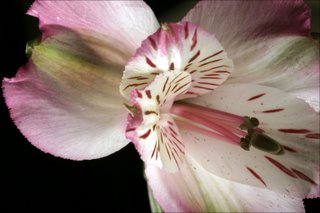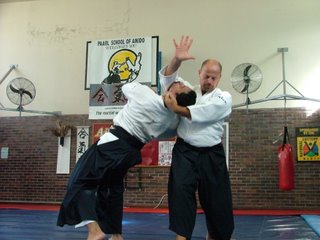 Sunday Seminar 02 July 2006 "Turning and returning to a secret place inside...."
Sunday Seminar 02 July 2006 "Turning and returning to a secret place inside...."Even an old hit from the Eighties can sometimes hold a universal truth . That song by Berlin ("Take my breath away") is currently making a comeback being sung by Jessica Simpson - but that was not why it suddenly popped into my head this week... :-)
This past fortnight we have been concentrating on a rather basic sequence of body movements this week - in response to a grab from
gyaku-hamni (or opposite posture), we turned in
tenkan, then open up our stance as
uke comes around and then entered in a triangulated fashion in order to execute the technique. And it did not matter what the technique was -
kokyu-nage, uchi kaiten-nage, kote-gaeshi, ikkyo - they all started out with this basic sequence of moves. And that got me thinking... Why this particular sequence?
Well at one level this sequence represents the three shapes upon which much of Aikido rests -
the circle, the square and the triangle. These three shapes have both a practical and a spiritual component - our triangular posture offers the smallest target to
uke and an easy wedge shape for entering into the face of an attack; the square describes how solid one's foundation needs to be in order to execute a technique; and the circle presents the most powerful shape to dissipate the incoming force. At another level these shapes depict different aspects of our engagement with this world.
In executing the movements, it is critical to maintain 2 points of contact - with
uke, and equally importantly with our own centre. And I believe it is important to maintain the critical distance (
ma-ai) between those two points throughout the movement - collapse the arm as you turn or as
uke comes around and you are liable to end up with a fist in your face as
uke enters your space; extend your arm as you turn and you may find yourself being pulled out of your centre by a strong
uke. Similarly, as you square yourself and then enter deeply to
uke's rear, maintaining this distance between your centre and
uke ought to result in an effortless technique as you find yourself in just the right place at just the right time. The power of
kokyo-rokyo lies after all in a combination of proper timing, precise body placement (
tai no henko) and calm breathing.
So ultimately this most basic combination of movements teaches us how important it is to be aware of who and where you are while being attuned and reactive to those around you.
Aikido teaches us to turn, and turn, and turn some more. This turning ultimately becomes a return. And that return is always to that "secret place inside" - inside you. So all this turning really teaches us to refocus on what is within our sphere of control - ourselves. And by maintaining that control over ourselves, we are able to extend our influence over those who come within that sphere - regardless of their original intention.
Tenkan (or turning) reminds us of our position relative to uke, rather than being distracted by uke's attack and intention for us. The power of that initial
tenkan lies in teaching us that the turn must happen within ourselves - that we must stop fighting and learn to turn the fight into something else.
Saotome Sensei said that
"the desired result of Aikido is not the physical power of technique; it is the power of wisdom. But solid technique is the first step, the foundation upon which to build. The movement and shape of the body reveal and simultaneously affect the movement and shape of the spirit".
So while we cannot reach inside
uke and change his/her negative intention/aggression (as demonstrated by his/her attack), through repositioning ourselves, through our own focused, centered, powerful, and most importantly, compassionate movement we can begin to help uke see a different way. Equally importantly, it can show ourselves a different way of reacting to the aggression of others; our body movements (
tai-no-henko), trained over time, help us overcome the mental block(s) we might have in the face of an attack, born from fear or stress.
Again Saotome Sensei says that
"within a movement of complete harmony, you cannot see the power, for there is no struggle. Balance, timing and the use of space and spiritual communication [the essence of kokyuho] become dynamic art...Aikido is a dynamic poem of movement...You cannot imitate the power of an ocean wave; you must become the ocean itself. You must see not just small technique but the entire picture of the movement. You must extend your creativity and create an image of power and reality. Your movement is a poem. You are the wind, the sun, a mountain, and, exactly, you are art".So in this simple combination of body movements lie the secret of transforming not just ourselves, but our relationship to the world around us, and ultimately the world itself.
O-Sensei said:
Contemplate the workings of this world, listen to the words of the wise and take all that is good as your own. With this as your base, open your own door to truth. Do not overlook the truth that is right before you. Study how water flows in a valley stream, smoothly and freely between the rocks. Also learn from holy books and wise people. Everything - even mountains, rivers, plants and trees - should be your teacher.
So you will have to forgive me as I now go off for a walk along a mountain path (aren't we lucky here in Cape Town that I can do that even in the heart of winter!!!) to find another teacher ;-)
See you on the tatami soon..









